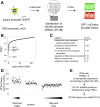A Whole-Genome RNA Interference Screen Reveals a Role for Spry2 in Insulin Transcription and the Unfolded Protein Response
- PMID: 28246293
- PMCID: PMC5440024
- DOI: 10.2337/db16-0962
A Whole-Genome RNA Interference Screen Reveals a Role for Spry2 in Insulin Transcription and the Unfolded Protein Response
Abstract
Insulin production by the pancreatic β-cell is required for normal glucose homeostasis. While key transcription factors that bind to the insulin promoter are known, relatively little is known about the upstream regulators of insulin transcription. Using a whole-genome RNA interference screen, we uncovered 26 novel regulators of insulin transcription that regulate diverse processes including oxidative phosphorylation, vesicle traffic, and the unfolded protein response (UPR). We focused on Spry2-a gene implicated in human type 2 diabetes by genome-wide association studies but without a clear connection to glucose homeostasis. We showed that Spry2 is a novel UPR target and its upregulation is dependent on PERK. Knockdown of Spry2 resulted in reduced expression of Serca2, reduced endoplasmic reticulum calcium levels, and induction of the UPR. Spry2 deletion in the adult mouse β-cell caused hyperglycemia and hypoinsulinemia. Our study greatly expands the compendium of insulin promoter regulators and demonstrates a novel β-cell link between Spry2 and human diabetes.
© 2017 by the American Diabetes Association.
Figures






Comment in
-
Checks and Balances-The Limits of β-Cell Endurance to ER Stress.Diabetes. 2017 Jun;66(6):1467-1469. doi: 10.2337/dbi17-0018. Diabetes. 2017. PMID: 28533299 Free PMC article. No abstract available.
Similar articles
-
Endoplasmic reticulum stress and glucose homeostasis.Curr Opin Clin Nutr Metab Care. 2011 Jul;14(4):367-73. doi: 10.1097/MCO.0b013e32834778d4. Curr Opin Clin Nutr Metab Care. 2011. PMID: 21543975 Review.
-
KAT2B Is Required for Pancreatic Beta Cell Adaptation to Metabolic Stress by Controlling the Unfolded Protein Response.Cell Rep. 2016 May 3;15(5):1051-1061. doi: 10.1016/j.celrep.2016.03.079. Epub 2016 Apr 21. Cell Rep. 2016. PMID: 27117420
-
A Syntenic Cross Species Aneuploidy Genetic Screen Links RCAN1 Expression to β-Cell Mitochondrial Dysfunction in Type 2 Diabetes.PLoS Genet. 2016 May 19;12(5):e1006033. doi: 10.1371/journal.pgen.1006033. eCollection 2016 May. PLoS Genet. 2016. PMID: 27195491 Free PMC article.
-
miR-204 Targets PERK and Regulates UPR Signaling and β-Cell Apoptosis.Mol Endocrinol. 2016 Aug;30(8):917-24. doi: 10.1210/me.2016-1056. Epub 2016 Jul 6. Mol Endocrinol. 2016. PMID: 27384111 Free PMC article.
-
The unfolded protein response is required to maintain the integrity of the endoplasmic reticulum, prevent oxidative stress and preserve differentiation in β-cells.Diabetes Obes Metab. 2010 Oct;12 Suppl 2(Suppl. 2):99-107. doi: 10.1111/j.1463-1326.2010.01281.x. Diabetes Obes Metab. 2010. PMID: 21029306 Free PMC article. Review.
Cited by
-
Biosynthesis, structure, and folding of the insulin precursor protein.Diabetes Obes Metab. 2018 Sep;20 Suppl 2(Suppl 2):28-50. doi: 10.1111/dom.13378. Diabetes Obes Metab. 2018. PMID: 30230185 Free PMC article. Review.
-
High-Throughput Quantitative Screening of Glucose-Stimulated Insulin Secretion and Insulin Content Using Automated MALDI-TOF Mass Spectrometry.Cells. 2023 Mar 9;12(6):849. doi: 10.3390/cells12060849. Cells. 2023. PMID: 36980190 Free PMC article.
-
Diabetes mellitus and the key role of endoplasmic reticulum stress in pancreatic β cells.Nat Rev Endocrinol. 2025 Sep;21(9):546-563. doi: 10.1038/s41574-025-01129-5. Epub 2025 Jun 4. Nat Rev Endocrinol. 2025. PMID: 40467970 Review.
-
Normal and defective pathways in biogenesis and maintenance of the insulin storage pool.J Clin Invest. 2021 Jan 19;131(2):e142240. doi: 10.1172/JCI142240. J Clin Invest. 2021. PMID: 33463547 Free PMC article. Review.
-
A Genetic Interaction Map of Insulin Production Identifies Mfi as an Inhibitor of Mitochondrial Fission.Endocrinology. 2018 Sep 1;159(9):3321-3330. doi: 10.1210/en.2018-00426. Endocrinology. 2018. PMID: 30059978 Free PMC article.
References
-
- International Diabetes Federation. IDF Diabetes Atlas, 7th edition [Internet], 2015. Available from http://diabetesatlas.org. Accessed 3 August 2016
-
- Imamura M, Iwata M, Maegawa H, et al. . Genetic variants at CDC123/CAMK1D and SPRY2 are associated with susceptibility to type 2 diabetes in the Japanese population. Diabetologia 2011;54:3071–3077 - PubMed
MeSH terms
Substances
Grants and funding
LinkOut - more resources
Full Text Sources
Other Literature Sources
Medical
Molecular Biology Databases

